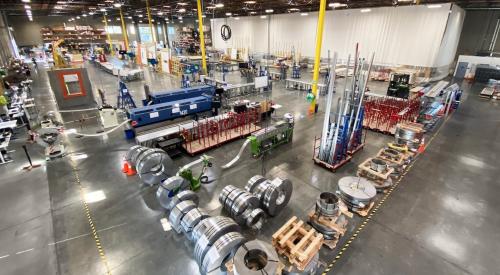When I was a much younger man, a close friend became obsessed with astrology. This former high-school valedictorian and regional science fair winner went all in on the stars, using them to analyze everything and everybody, from U.S. presidents to parents to my marriage prospects with a new girlfriend. He talked about moon phases, this star aligning with that galaxy, and how a particular planetary conjunction explained the stock market’s rise or a baseball team’s fall. Listening to him made my head spin like Jupiter’s moons.
But one of his astrology terms stuck with me and applies to perhaps the greatest change we’ll ever witness in home building: the Great Convergence.
Learning From Other Industries: The Quality Movement and Automakers
There was an earlier convergence—not of the stars but of business and culture—in a different industry (automotive) that eventually had a profound impact on home building. It began with the Japanese quality movement of the 1950s, from which the tools and techniques of quality, productivity, and Lean process spread from Japan to Korea and later to at least some European automakers.
By 1980, U.S. automakers had fallen so far behind that many experts predicted there would be no American-built vehicles by the year 2000. And, after decades complaining about predatory pricing and unfair trade practices, the Detroit gang finally woke up and accepted the source of the problem was overseas competition becoming much more efficient, with far better quality than domestic producers.
In fact, foreign competitors didn’t steal American market share, as the politicians decried; rather, they earned it by providing superior value. Higher quality, better gas mileage, and lower cost offered a potent combination many consumers couldn’t overlook.
RELATED
- Off-Site Construction Drivers and Enablers—The Great Convergence, Part 2
- Housing, Industrialized: Your Road Map to Off-Site Construction
- Forecasting the Future of Home Construction
- Is Now the Time for Off-Site Construction? [VIDEO]
It took considerable time and tremendous investment, but U.S. automakers slowly caught up, to the point where American quality and productivity began to rival the best foreign competition in the early 2000s. Today, U.S.-built cars don’t just meet the quality and value of overseas product, they often exceed it.
That convergence of technology and culture in automobile production helped wake up our own building industry during the 1990s. Back then, I was the sole building industry member of the “Detroit Deming Study Group,” which met with the late Dr. W. Edwards Deming, the venerable quality guru, during his monthly trips to Detroit to help turn around American carmakers—40 years after he had done the same for Japan!
I felt a bit lonely sitting with 40 to 50 automotive quality and production experts, and their attitude toward me was, “What are you doing here?” They were reacting to the legacy of post-war “tract housing” in this country—not one to be especially proud of. You may not have been around to build them, but many of you lived in those poorly built homes.
The convergence of technology and culture in automobile production helped wake up our own building industry during the 1990s.
The change in home building began, just as in automotive, with a focus on back-end “inspect it in” quality through massive rework, described as “brute-force quality.” Gradually, we began to understand the need to move upstream to a prevention model and, as a result, product improved—though we’ve yet to reach the automotive industry’s levels of quality, efficiency, and “build it right the first time” mentality and practices. Many builders still haven’t gotten the message. On the whole though, homes now are much better than those of the previous era.
Yet—and this is a critical point—home building productivity lags behind virtually every other industry. What are we doing about it?
The Fourth Wave: Off-Site Production Enters the Housing Mainstream
Now comes the new great convergence in home building: the manufacturing and technology revolution that will change our industry forever. I’m talking about a pervasive shift to off-site construction methods.
I’m in my fourth decade in home building, and this is the Fourth Wave I’ve experienced pushing the claim that off-site (factory-built, industrialized, building systems—call it what you want) production will enter housing’s mainstream, none of the past waves having lived up to the hype or expectations. In a previous column, I described how the late Bill Pulte told his three-day training class for new management recruits how the manufacturing revolution in home building was only “this far”—holding his thumb and forefinger about an inch apart—from happening in the 44 years since the end of World War II. That was in 1989.
Nearly 30 years after that class, and not long before his passing, I asked Bill for an update on home building’s manufacturing transformation. With a wry smile, he held up his thumb and forefinger again, this time less than half an inch apart, and declared, “Today … about THIS far.” He then added, “It will happen though. Maybe not in my lifetime, but certainly in yours.”
I am crawling out on a lam-beam here and declaring the Fourth Wave is here for real and it will change home building forever.
That’s how far we’d come in the nearly 75 years since the mid-1940s. But it’s worse than that. Look back at Sears Roebuck & Co., which built and shipped 70,000 complete home kits from 1908 through 1940 through its mail-order Modern Homes program. Each piece of the home was precut and labeled, including framing, wiring, plumbing, flooring, cabinets, and so on ... even the proverbial kitchen sink.
Those homes were great when they were built, and they’re still great today. I know because until grade six I grew up in one of those homes in southern Indiana, as did my grandparents in another home just around the corner. I can drive you through my current hometown of Plymouth, Mich., and show you at least 25 of these Sears houses (although some may be almost exact knockoffs of Sears plans built by other manufacturers), all remodeled and updated numerous times over the years. They’re still solid family homes today. Once you know their look, you’ll find them across America.
That’s Progress! Home Building Embraces Construction Technology
Pause a moment here to consider how much the design and production of automobiles has progressed in the past 100 or so years. How about airplanes? Appliances? Audio equipment? Telephones? Electronics? Television wasn’t even a fantasy in 1922, let alone cell phones and the internet.
How about the evolution of homes? Compared with those industries, home building’s progress has been marginal, at best. Today, fewer than 3% of new homes are manufactured off-site. Fewer than 5% are panelized, even at the most basic level. Trusses have 60% market penetration, yet, if you measure the true total cost of on-site vs. off-site methods, including the impact of saved schedule days, that figure should be more than 90%.
Given these past 100 years of performing below expectations, how can I now assert that today, off-site manufactured solutions are about to transform the home building industry? Yes, I am crawling out on a lam-beam here and declaring the Fourth Wave is here for real and it will change home building forever.
I base this on a simple observation of what’s going on all around us, evidenced at the most recent National Association of Home Builders’ International Builders’ Show, in Orlando, Fla. The number of new technology companies focused on all phases of home building was incredible, the excitement palpable. And, notably, there were investors roaming around with briefcases full of money, looking to invest in “the next big thing” in housing.
Personally, I’m now working with three companies that are pushing significant changes in the technology, one that’s been around for decades, one now about five years old, and one brand new. Just last week, another “old-line” firm and an additional brand new one contacted me, asking for help in this arena. If I sign any more nondisclosure agreements, I fear I won’t be able to talk to my own family members. These aren’t just “interesting times” but genuinely exciting ones.
What’s Driving Home Building Toward Off-Site Construction Methods
It’s easy to identify at least 10 significant changes driving or enabling this change. I’ve listed them here for you to consider, and will follow up with more detail on each in my next column. There are, no doubt, more elements, and I’d love to hear your take on what’s driving the movement toward off-site methods—or what’s holding it back. Here’s what I see as the key drivers (1 through 5) and enablers (6 through 10):
1. Housing demand and shortage
2. Labor shortages
3. Material shortages
5. Sustainability
6. Availability of investment capital
7. Technology breakthroughs in computer software
8. Technology breakthroughs in robotics
9. Learning-curve acceleration
10. New methods for making “true total cost” comparisons
From my experience, those elements make it clear we are genuinely on our way in this, the Fourth Wave of the manufacturing technology revolution in housing. But there is still a critical missing link, and without it, progress will be slow. Simply, we have to be brutally honest and consider why the vast majority of home building software technologies still fall short of their promised impact.
For example, most all of the many packages designed to make scheduling a breeze by publishing to a portal accessed 24/7 by suppliers and trades are simply not working. We’re surrounded by irrefutable evidence of this. When we run our TrueNorth LeanWeeks with 20 to 30 suppliers and trades participating, we always ask, “How many of you have someone check jobsites the day before the schedule says they’re ready, to determine if you should really send out a crew or deliver materials?”—a practice we call scouting. Across literally hundreds of groups, the number of hands raised averages 80%.
The next question, “Why do you not use the portal to replace the considerable expense of scouting?” is at first followed by nervous laughter across the room. With some coaxing, one brave soul will inevitably explain, “We just can’t trust it,” after which you’ll see all suppliers and trades nodding in unison, along with builder field superintendents as well.
RELATED
- The Synergy of Industrialized Construction and Built-for-Rent Housing
- Veev’s Amit Haller on Scaling Innovation and Shortening the Supply Chain
- Lean Construction’s Greatest Hits, Vol. 1
Again, there’s nothing wrong with the software itself. But the fact that 80% of suppliers and trades are scouting sites instead of relying on software is prima facie evidence that systems are failing at some point in the process. The problem is that in today’s world of labor and material shortages, these portals are worse than worthless if the system isn’t updated for each project, each day (at least), both in the field and in the office.
Worse than worthless? Absolutely. Because if the portal schedule sends the wrong crew or a delivery to the wrong place, or the right place on the wrong day, the cost is huge in supplier/trade loyalty and, ultimately, in pricing. I learned decades ago from great mentors, such as Mike Rhoads in Chicago and Gary Grant in Minnesota, that builders with the best schedulers get the best crews and best pricing, simply because they are the most profitable for suppliers and trades.
Now make the translation to the application of manufacturing technology. Plans, elevations, specifications, options, and selections that affect the off-site building process must be continually transmitted and confirmed. That goes for comparatively simple components such as stairs, cabinets, and open panels, as well as more complex production of closed panels, all of the way to full-on modular or “volumetric” building. This information must be so reliable that the off-site plant can absolutely take it to the bank, without exception.
I once asked the president of a large home building company in a distant city to name his most difficult supplier in terms of communication and cooperation. He didn’t hesitate, proclaiming, “The panel plant.” Irony No. 1: The panel plant made the identical comment about the builder. Irony No. 2: Both builder and plant were owned by the same parent company. Whenever someone says a company should be more like a family, my first question is, “Which family?” This particular “family” was clearly dysfunctional.
Making the Off-Site Construction Revolution a Reality
Continual, vigilant, completely accurate and timely communication means everything for reaping the promise of the Fourth Wave from which our industry is truly revolutionized. Anything less means failure, and the dream of better product at lower cost, with less dependence on on-site labor, and significant reduction in cycle time will remain forever elusive. The home building stars are now well-aligned for this revolution, and it’s up to all of us, on all sides of this rather complex equation, to do our part to make it happen.
Will my prediction prove out? Thinking back on my astrology-obsessed friend’s predictions, I expect to fare much better. He got some right, but many wrong, including his warning that my then-girlfriend and I were in for big trouble should we marry. I’m happy to report—45 years, four kids, and three grandkids later—I woke up next to her this morning with both of us agreeing: So far, so good!













